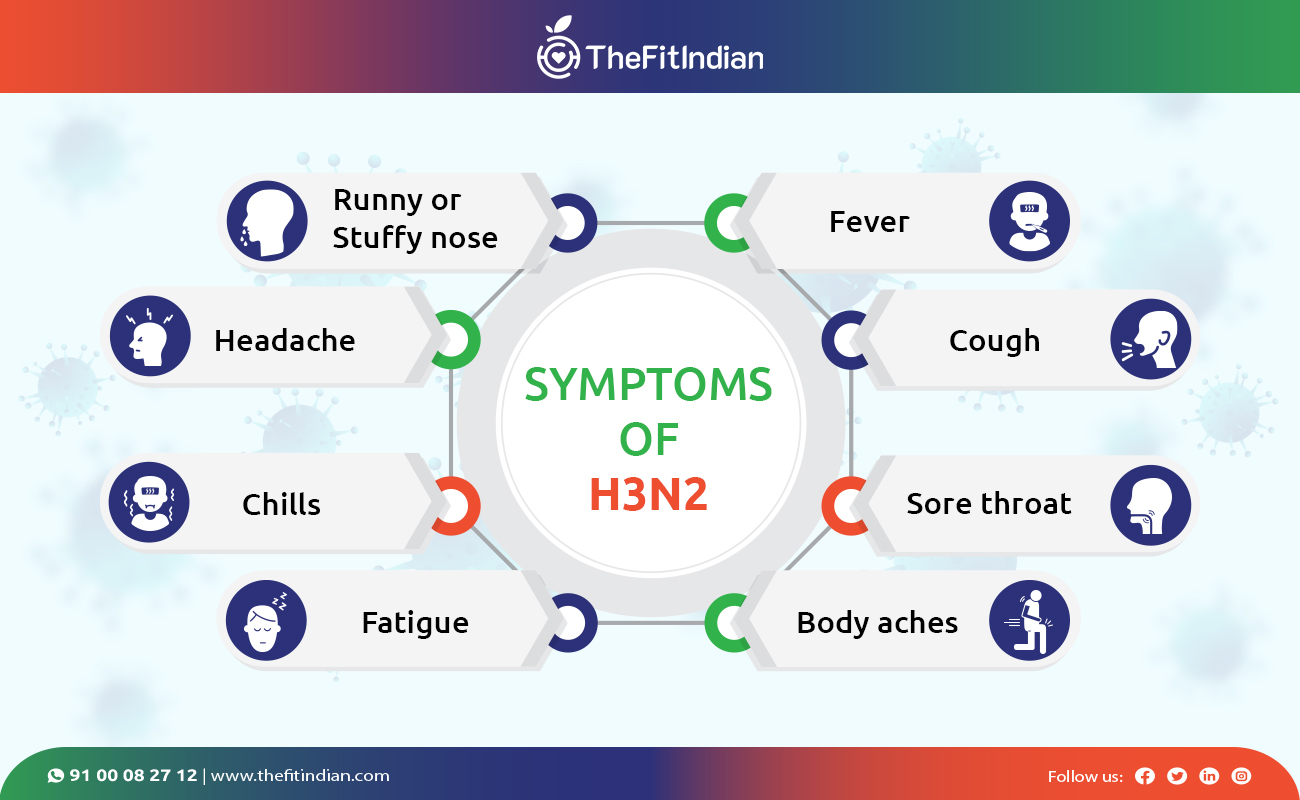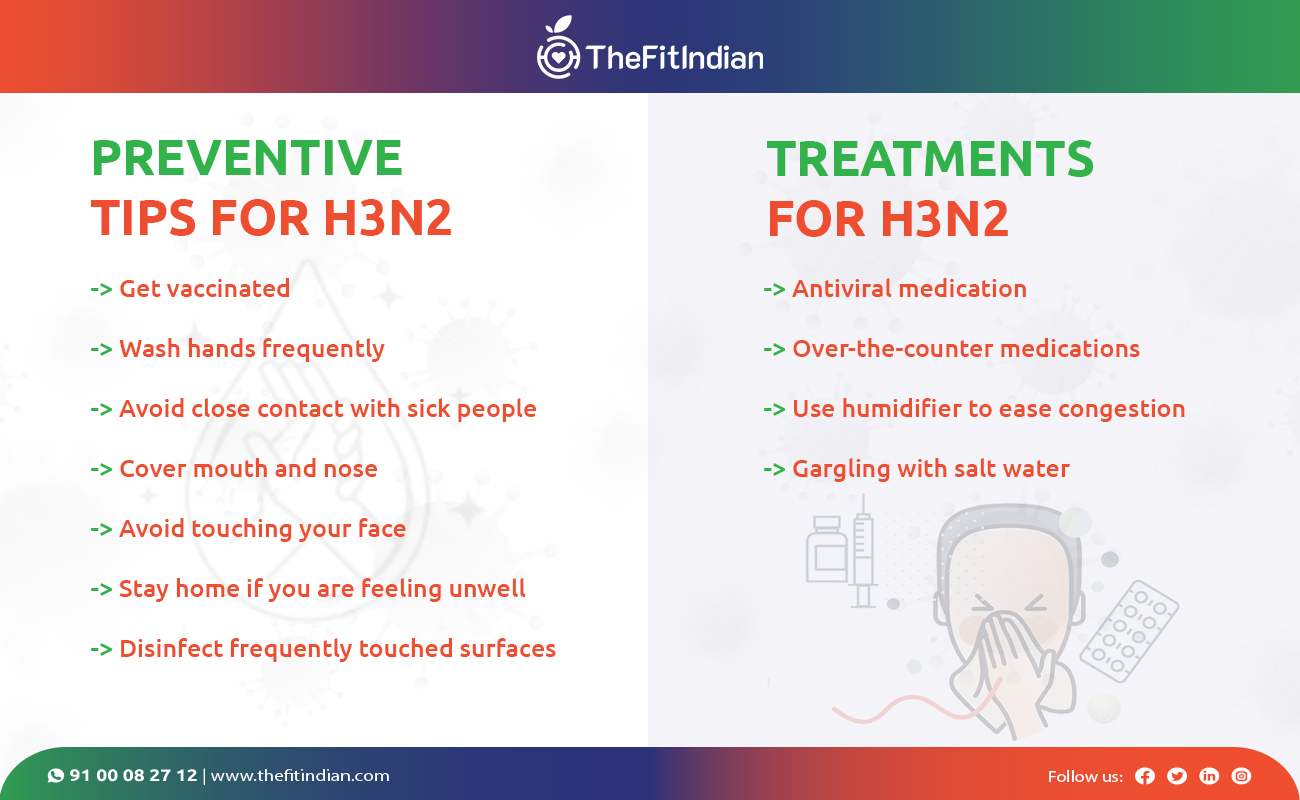H3N2 Virus – Symptoms, Transmission, Preventions, and Diet Tips
Reviewed by: Dr. T S Deepthi Sarojini | Author: Manoja Kalakanti
Uh oh, it is that time of year again. The dreaded flu season is upon us, and this year’s villain is the infamous H3N2 virus. This bad boy is part of the same family as other notorious viruses like H1N1 and H5N1, which makes it a force to be reckoned with.

H3N2 is highly contagious and can cause severe illness and even death in some cases. So, knowing the signs and symptoms and the steps you can take to protect yourself is crucial. In this blog, we will explore how H3N2 is related to other viruses, the H3N2 signs and symptoms to look out for, how it spreads, the available treatments, and some diet tips to keep your immunity boosted and H3N2 at bay. Grab a cup of tea and a box of tissues, and let us dive into the world of the H3N2 virus.
Correlation of H3N2 with Other Viruses of Its Family
Before we delve into the specifics of H3N2, let us clarify what it is. H3N2 is an influenza virus from the Orthomyxoviridae family, including other notorious viruses such as H1N1 and H5N1. These viruses are known for their ability to cause respiratory illness, and they pose a significant threat to public health due to their high contagion and rapid mutation rates. The H3N2 virus has undergone several mutations, leading to the emergence of new variants that can cause severe illness and even death.
The H1N1 virus caused a pandemic in 2009 and is still circulating as a seasonal flu virus. On the other hand, the H5N1 virus primarily affects birds but can also infect humans and cause severe illness. Furthermore, influenza viruses are known to mutate rapidly, which can lead to the emergence of new strains with the potential to cause pandemics. It is crucial to monitor the circulation of these viruses to understand the potential risk they pose to public health. In addition, by understanding the correlation of other viruses with H3N2 and its family, we can identify emerging strains and take appropriate measures to prevent their spread.
Researchers have found several similarities between the H3N2 virus and other influenza viruses in its family. For example:
H3N2 and H1N1 viruses have similar transmission modes and cause similar symptoms.
H3N2 and H5N1 viruses have similar genetic structures and share some of the same proteins.
H3N2, H1N1, and H5N1 viruses are all known to undergo rapid genetic changes, which can lead to the emergence of new strains.
By understanding the correlation of H3N2 with other viruses of its family, scientists can develop better strategies for monitoring and controlling the spread of these viruses. So now let us study the signs and symptoms, treatments, and transmission of H3N2 influenza.
H3N2: Symptoms and Transmission

Symptoms of H3N2
The H3N2 virus symptoms are similar to other strains of the flu virus and can vary from person to person. Some common symptoms include:
- Fever
- Cough
- Sore throat
- Body aches
- Fatigue
- Chills
- Headache
- Runny or stuffy nose
H3N2 can cause complications such as pneumonia, bronchitis, or worsening medical conditions in severe cases.
Transmission of H3N2
H3N2 is highly contagious and can spread quickly from person to person. The virus is predominantly transmitted through respiratory droplets when a contaminated person sneezes, coughs, or talks. However, it can also spread by touching contaminated surfaces and your mouth, nose, or eyes.
Preventive Tips and Treatments for H3N2 Virus

Protect yourself and your family with these easy-to-follow H3N2 virus preventions:
1. Get vaccinated annually:
The best way to prevent the flu is to get vaccinated. The annual flu shot can help protect you and your loved ones from H3N2 and other flu viruses.
2. Wash your hands frequently:
Proper handwashing is one of the most effective ways to prevent the spread of germs. Be sure to lather up with soap and water for at least 20 seconds, especially after being in public spaces.
3. Avoid close contact with sick people:
If someone around you is sick with flu-like symptoms, try to avoid close contact with them to prevent the spread of the virus.
4. Cover your mouth and nose:
When you cough or sneeze, be sure to cover your mouth and nose with a tissue or the crook of your elbow. This helps prevent the spread of respiratory droplets that can carry the virus.
5. Avoid touching your face:
The flu virus can enter your body through your eyes, nose, and mouth, so try to avoid touching your face as much as possible.
6. Clean and disinfect frequently touched surfaces:
Surfaces like doorknobs, keyboards, and phones can harbor flu germs. Regular cleaning and disinfecting can help prevent the spread of the virus.
7. Stay home if you are feeling unwell:
If you are experiencing flu-like symptoms, stay home to avoid spreading the virus to others.
By following these simple steps, you can help reduce your risk of contracting H3N2 or any other flu virus this season. Here are a few treatment options for H3N2 influenza.
Treatments of H3N2
The treatment for H3N2 is similar to other strains of the flu virus and focuses on relieving symptoms and preventing complications. Some common treatment options include:
- Antiviral medication: These medications can help reduce the duration and severity of illness, but they are most effective when taken within 48 hours of the onset of symptoms. Antiviral medications work by blocking the virus from replicating in the body.
- Over-the-counter medications: Pain relievers, fever reducers, and decongestants can help relieve symptoms such as fever, cough, and congestion. However, it is essential to follow the dosing instructions carefully and avoid using multiple medications that contain the same active ingredient.
- Using a humidifier to ease congestion.
- Gargling saltwater to soothe a sore throat.
It is crucial to seek aid from an experienced doctor if you experience severe symptoms or are at risk of developing complications. It is important to note that antibiotics are ineffective against viral infections such as H3N2. In the next section, we will look into the preventive tips not to get infected by the H3N2 virus.
Tips to Boost Immunity to Keep H3N2 at Bay

The best way to prevent H3N2 is by getting vaccinated. The flu vaccine can help reduce the risk of getting sick and the severity of symptoms if you do get sick. In addition to getting vaccinated, you can take several other steps to boost your immune system and keep H3N2 at bay. These include:
1. Eat a Healthy Diet
A well-balanced H3N2 diet rich in nutrients can help support a healthy immune system. Eat plenty of fruits, vegetables, lean protein, whole grains, and healthy fats. Some foods that are particularly beneficial for immunity include:
- Eat various fruits and vegetables: These are rich in vitamins, minerals, and antioxidants that help support a healthy immune system. Aim for at least 5 servings per day.
- Include lean protein sources: Protein is essential for building and repairing tissues, including immune cells. Good sources include lean meats, poultry, fish, beans, and lentils.
- Choose whole grains: Whole grains like brown rice, quinoa, and whole wheat provide complex carbohydrates that give your body the energy it needs to fight off infections.
- Add healthy fats: Omega-3 fatty acids, found in fatty fish like salmon and tuna, as well as nuts and seeds, can help reduce inflammation and boost immunity.
- Spice it up: Garlic, ginger, turmeric, and other spices and herbs are packed with antioxidants and anti-inflammatory compounds that can help protect against viruses like H3N2.
- Hydrate with fluids: Drinking plenty of fluids, such as water, tea, and broth, can help keep mucous membranes moist and flush out toxins.
Get Enough Sleep
Getting enough rest is vital for overall health, including immune function. Aim for at least 7 to 8 hours of sleep per night.
Exercise Regularly
Regular exercise can help to boost immune function and reduce the risk of infection. Therefore, 30 minutes of moderate-intensity exercise is recommended on most days of the week to boost immunity.
Stay hydrated
Drinking plenty of water helps keep your mucous membranes moist, which can make it harder for viruses like H3N2 to take hold in your body. Try warm water with lemon: Sipping warm water with a squeeze of fresh lemon can help boost your immune system and flush out toxins, potentially reducing your risk of getting sick.
Manage Stress
Stress can weaken the immune system, so finding ways to manage stress effectively is crucial. This includes meditation, yoga, deep breathing, or time in nature.
Quit Smoking
Smoking impairs immunity and raises the risk of respiratory illnesses like H3N2. So, one of the best things you can do for your immune system and general health is to stop smoking.
Incorporating these tips into your daily routine can help support a strong immune system and reduce your risk of H3N2 virus deaths. However, it is essential to remember that these tips are not a substitute for medical treatment and should be used with other preventive measures such as vaccination and good hygiene practices.
Summing Up
In conclusion, H3N2 is a highly contagious virus that can cause severe respiratory illness. While it can be difficult to prevent infection entirely, there are steps you can take to reduce your risk and minimize the severity of symptoms. By staying advised about the latest developments and following the guidelines from health authorities, you can help protect yourself and others from H3N2.
Remember, the best defense against the H3N2 virus is a strong immune system, so be sure to eat a healthy diet, get enough sleep, exercise regularly, manage stress, and quit smoking. And do not forget to practice good hygiene habits, such as washing your hands regularly and covering your mouth and nose when coughing or sneezing. By taking these steps, you can help reduce your risk of H3N2 and other respiratory infections. So, stay healthy, stay informed, and stay safe!
FAQs
H3N2 is a strain of the influenza A virus. It stands for hemagglutinin 3 and neuraminidase 2, which are proteins found on the surface of the influenza A virus.
The main differences between H1N1, H2N2, and H3N2 are the specific subtypes of hemagglutinin and the neuraminidase proteins they possess. H1N1 caused the Spanish flu pandemic in 1918, H2N2 caused the Asian flu pandemic in 1957, and H3N2 caused the Hong Kong flu pandemic in 1968.
H3N2 is considered more virulent than other strains of the flu virus due to mutations in its surface proteins that allow it to evade the immune system.
H3N2 flu is a strain of the influenza A virus that primarily spreads through respiratory droplets and can cause symptoms such as fever, cough, sore throat, runny or stuffy nose, body aches, and fatigue.
Yes. H3N2 can affect people of all ages, but it is more commonly reported in children and older adults.
The H3N2 virus is included in the seasonal flu vaccine in India, and individuals at high risk are recommended to get vaccinated annually. The strategy for dealing with the H3N2 virus in India involves early detection, isolation, and treatment of infected individuals, as well as promoting good hygiene practices to prevent the spread of the virus.
Early signs of the H3N2 virus can include fever, cough, sore throat, and body aches.
Yes. Breathing problems can be a symptom of the H3N2 virus, particularly in individuals with underlying respiratory conditions or in severe cases.
H3N2 is an influenza A virus that spreads through respiratory droplets, causing fever, cough, sore throat, and fatigue. COVID-19 is caused by SARS-CoV-2, highly contagious with symptoms such as fever, cough, shortness of breath, fatigue, and body aches, and can cause severe respiratory illness with a higher mortality rate than H3N2.
The H3N2 vaccine is crucial for adults, particularly those at high risk, as it can help prevent severe illness and reduce the risk of complications, hospitalization, and death. Getting vaccinated can also protect others in the community who cannot get vaccinated or have weakened immune systems.

Manoja Kalakanti